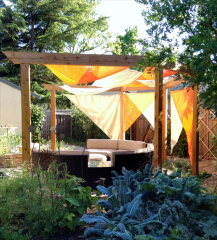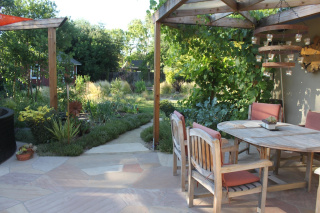Showcase Feature
Inspired by the Bringing Back the Natives Garden Tour, in 2012 Gaston and Ariane removed their very large back lawn, and worked collaboratively with Liz Simpson of Liz Simpson Garden Design to create the beautiful, water-conserving, bird- and bee-friendly garden they had in mind.
This project was so successful that they then sheet mulched away their front garden. Sunny areas are now home to bush anenomies, sages, and blue-eyed grass. In the shade of their mature tree, dogwood, hazelnut, sword ferns, coral bells, and fragrant yerba buena thrive.
Among the plethora of inviting and functional features included in the expansive back garden are a drilled rock fountain, breakfast nook, custom-made stone benches, and a hidden petanque court. You’ll enjoy discovering the intimate “rooms” that are revealed as you move through the garden. Plants serve as walls, and the rooms are connected with curving pathways that lead one onward and provide a sense of mystery. Drop down in one of the many seating areas in this spectacular garden and enjoy it; you won’t want to leave.
Other Garden Attractions
- In the front garden a swale catches rainwater, allowing it to percolate naturally into the water table.
- The outdoor dining area is sheltered by an arbor, shaded by various vines.
- Gaston built the shed with wood salvaged from the former deck.
- A 500 gallon rainwater catchment is used to water some of the vegetables.
- Just a few steps from the back door a variety of herbs and vegetables are grown, ready to be harvested for the family dinner.
- The Habets’ electric bill is nearly zero, thanks to the 5 KW solar panels they installed!
- Visit the Contra Costa Water District’s table, chat with their friendly staff member, and find out how you can receive a rebate of up to $1000 to remove and replace your lawn with a water-wise garden! Information will be available on CCWD’s Lawn to Garden Rebate Program and how you can get a free landscape garden design. If you include 70% or more natives in your new plan you can have your own garden on the Tour!
Gardening for Wildlife
Many beneficial insects began visiting the garden when the lawns were removed and California natives planted. Now butterflies and carpenter, bumble, and other native bees are common sights. Woodpeckers have nested in the garden; nest boxes are provided for other avian species. Plants in this garden that butterflies and moths can lay their eggs on – known as larval host plants – include oaks, lupine, manzanitas, currants, sages and more. Did you know that the babies of most birds require caterpillars while in the nest? (Thousands of them!) Baby birds do not eat seeds, or berries, or sugar water – they must have caterpillars. Did you also know that butterflies and moths will only lay their eggs on a very few types of plants – without those plants we won’t have butterflies — or baby birds. Watch this terrific video of a Douglas Tallamy talk, check out the list of larval host plants and the number of butterfly and moths that will lay eggs on them, plant some of these plants in your garden today, and rejoice when you see caterpillars!
Green Home Features
Solar panels, heat pump for heating and cooling the house, whole house fan, induction range, electric dryer, electric car, swale:
Photos
Click to see as a slideshow:
- Habets



















